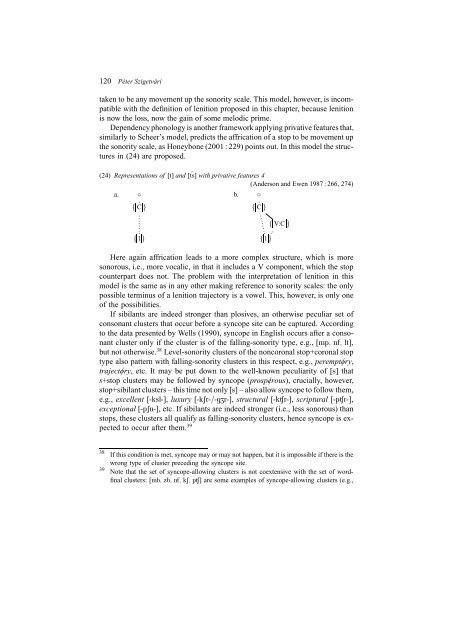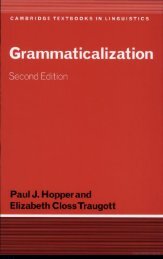What and where? Péter Szigetvári - SEAS
What and where? Péter Szigetvári - SEAS
What and where? Péter Szigetvári - SEAS
Create successful ePaper yourself
Turn your PDF publications into a flip-book with our unique Google optimized e-Paper software.
120 <strong>Péter</strong> <strong>Szigetvári</strong><br />
taken to be any movement up the sonority scale. This model, however, is incompatible<br />
with the definition of lenition proposed in this chapter, because lenition<br />
is now the loss, now the gain of some melodic prime.<br />
Dependency phonology is another framework applying privative features that,<br />
similarly to Scheer’s model, predicts the affrication of a stop to be movement up<br />
the sonority scale, as Honeybone (2001 : 229) points out. In this model the structures<br />
in (24) are proposed.<br />
(24) Representations of [t] <strong>and</strong> [⁀ts] with privative features 4<br />
(Anderson <strong>and</strong> Ewen 1987 : 266, 274)<br />
a. ◦<br />
{ C }<br />
{ l }<br />
b. ◦<br />
{ C }<br />
{ l }<br />
{ V:C }<br />
Here again affrication leads to a more complex structure, which is more<br />
sonorous, i.e., more vocalic, in that it includes a V component, which the stop<br />
counterpart does not. The problem with the interpretation of lenition in this<br />
model is the same as in any other making reference to sonority scales: the only<br />
possible terminus of a lenition trajectory is a vowel. This, however, is only one<br />
of the possibilities.<br />
If sibilants are indeed stronger than plosives, an otherwise peculiar set of<br />
consonant clusters that occur before a syncope site can be captured. According<br />
to the data presented by Wells (1990), syncope in English occurs after a consonant<br />
cluster only if the cluster is of the falling-sonority type, e.g., [mp, nf, lt],<br />
but not otherwise. 38 Level-sonority clusters of the noncoronal stop+coronal stop<br />
type also pattern with falling-sonority clusters in this respect, e.g., perempt/ory,<br />
traject/ory, etc. It may be put down to the well-known peculiarity of [s] that<br />
s+stop clusters may be followed by syncope (prosp/erous), crucially, however,<br />
stop+sibilant clusters – this time not only [s] – also allow syncope to follow them,<br />
e.g., excellent [-ksl-], luxury [-kSr-/-gZr-], structural [-kÙr-], scriptural [-pÙr-],<br />
exceptional [-pSn-], etc. If sibilants are indeed stronger (i.e., less sonorous) than<br />
stops, these clusters all qualify as falling-sonority clusters, hence syncope is expected<br />
to occur after them. 39<br />
38<br />
If this condition is met, syncope may or may not happen, but it is impossible if there is the<br />
wrong type of cluster preceding the syncope site.<br />
39<br />
Note that the set of syncope-allowing clusters is not coextensive with the set of wordfinal<br />
clusters: [mb, zb, nf, kS, pÙ] are some examples of syncope-allowing clusters (e.g.,
















